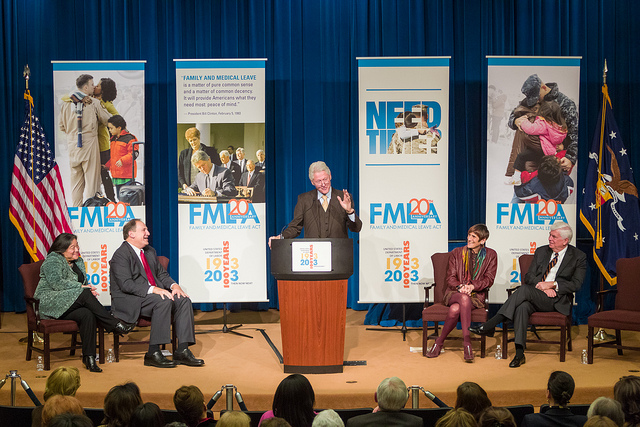No others are owed a greater measure of gratitude for our rights and freedoms than the men and women who answer the call to serve in our armed forces. That is why the Labor Department works to help service members transition from the military to good civilian jobs, and why we announced changes to the Family and Medical Leave Act on Tuesday that specifically benefit military families.

Former President Bill Clinton delivers remarks during the 20th anniversary celebration of the Family and Medical Leave Act.
The expanded rule implements congressional amendments to the FMLA that will allow caregivers of certain veterans with a serious injury or illness time they need to make their loved ones well. The rule permits eligible workers to take up to 26 workweeks of leave to care for a veteran, and expands the ability of workers to take leave for qualifying situations when a family member is deployed, among other provisions.
I was honored to announce the new rule standing alongside former President Bill Clinton, former Sen. Chris Dodd, Rep. Rosa DeLauro and Tina Tchen, the First Lady’s chief of staff. You can view a video of the event here, and you can learn more about the rule at the Wage and Hour Division’s FMLA final rule website.
President Obama speaks often about our obligation to America’s veterans, and this administration is committed to ensure transitioning service members and veterans find their place in America’s middle class. The most recent report from the department’s Bureau of Labor Statistics on veterans unemployment gives us some cause for optimism, but also indicates there is room for improvement, especially among veterans returning from Iraq and Afghanistan.
Overall, veterans unemployment remains lower than that of non-veterans; it has fallen to 7.0 percent as of January 2013 (12-month moving average), the lowest since 2009 (see chart below). However, while veterans from the post-9/11 era have seen their unemployment rate decline by 3.5 percentage points since peaking two years ago, their unemployment rate still hovers at 11.7 percent. That is much too high, and the Labor Department is determined to continue working with veterans seeking good jobs.

Veterans and non-veterans unemployment, April 2007 to January 2013. Source: Bureau of Labor Statistics, Current Employment Statistics Program
Our Veterans’ Employment and Training Service − working with our other agencies, including the Employment and Training Administration − is meeting this ongoing challenge head on. Keith Kelly, our new assistant secretary for veterans employment and training, will be leading these efforts. You can learn more about Keith by reading his blog from Monday, Combat Veteran Presents His Vision for Leading VETS.
For example, this year, our Transition Assistance Program − TAP − will serve approximately 200,000 transitioning service members and their spouses through three-day employment workshops. And we offer hands-on assistance to veterans and military families through American Job Centers. Veterans seeking job training or placement assistance, or just advice about how to improve their resumes, will receive priority service in any of our 2,717 centers (follow the link to locate a center near you). Online tools like My Next Move for Veterans are making it easier for veterans to connect with employment opportunities, too.
We’re also ensuring employers meet their obligations to protect civilian job rights and benefits for veterans and members of the military’s active and reserve components. In fiscal year 2012, we investigated and closed approximately 1,500 cases under the Uniformed Services Employment and Re-employment Rights Act, known as USERRA.
And we’re doing our part to end veteran homelessness with VETS’ Homeless Veterans’ Reintegration Program, the Homeless Female Veteran and Veterans with Families Program, and the Incarcerated Veterans Transition Program. These programs enrolled 16,413 participants in 2011, providing them with support and services to re-enter the workforce.
How we treat our veterans − and their families − says a lot about who we are as a nation. We can all be proud of the new FMLA rule, which lends a helping hand to the families that support America’s heroes. And we’re honored to continue serving those who have sacrificed so much for us.
Seth D. Harris is the acting U.S. Secretary of Labor.
{ 0 comments }
